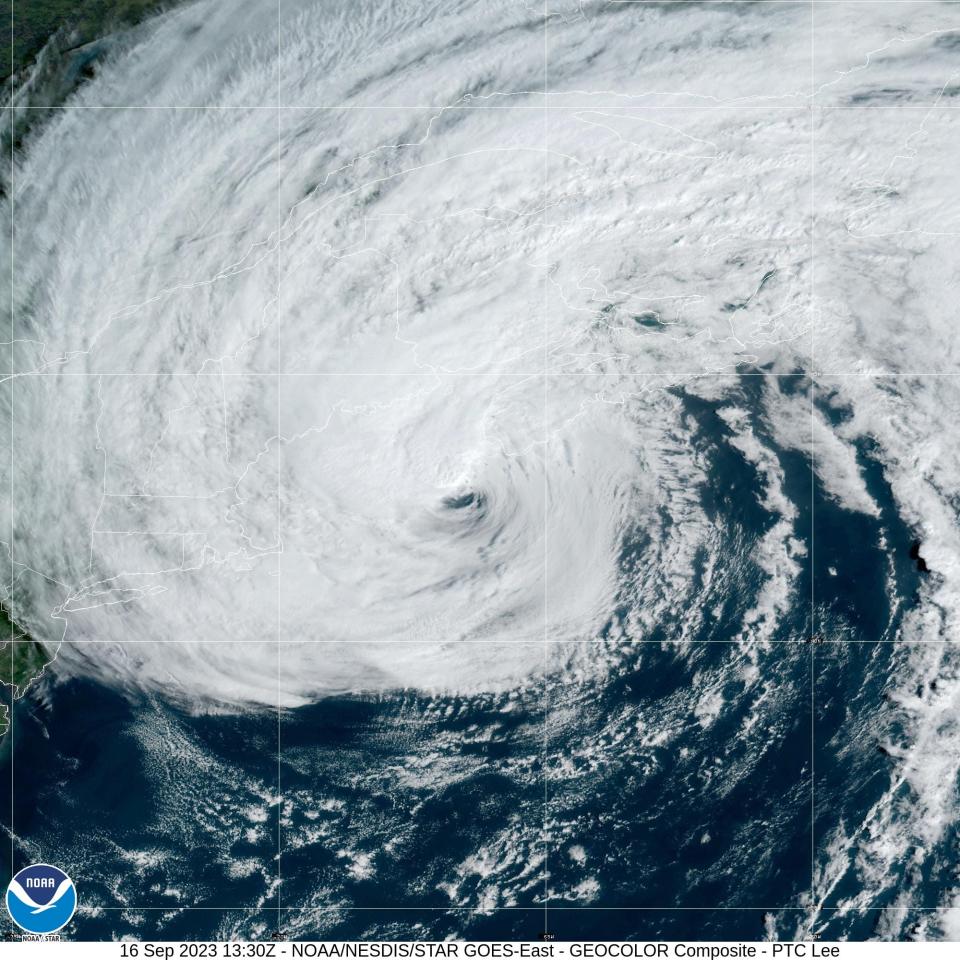Hurricanes almost never hit New England. That could change as the Earth gets hotter.
- Oops!Something went wrong.Please try again later.
Long-time New England residents are far more used to battening down for nor'easters than dealing with hurricane effects.
But potent winds from Lee − once a Category 5 hurricane − that churned in the Atlantic near the New England coast have served as a reminder that powerful storms can still pose a threat, even in these comparatively cold, Northern waters. And that threat could be growing.
When the storms do find their way northward along the Atlantic coast, they tend to weaken. Cooler ocean temperatures, drier air and stronger winds don't offer the kind of support hurricanes need.
While water temperatures have been warmer than normal in the Northeast, they're still nowhere near the bathtub-like temperatures in the South. And hurricanes need warm water for energy.
Still, some studies suggest conditions could become more conducive to more hurricane winds in the region as climate change continues to unfold.
How is climate change playing a role in hurricanes in the Northeast?
Just how climate change may affect tropical cyclones is still a subject of intense research and debate, but many scientists agree rainfall is increasing in storms and that storms are having more impact when they make landfall because sea levels have risen.
Several studies also suggest hurricane activity and the potential for higher winds is likely to expand northward on a warming planet.
Tropical cyclones are most often found at lower latitudes, where they find warm ocean water that serves as fuel for a storm. It’s also a region where powerful jet streams are less likely to shear off the tops of clouds, which allows hurricanes to build the engines that drive them.
But a 2021 study led by scientists at Yale University found a warming planet could mean hurricanes spin farther north than they used to, affecting cities such as New York and Boston. That study was released shortly after Henri – a hurricane that weakened to a tropical storm before making landfall in Rhode Island – swamped the Northeast with high winds and record-breaking rainfall.
Kerry Emanuel, a meteorologist and climate scientist at the Massachusetts Institute of Technology, told USA TODAY on Friday that researchers have recently studied hurricane risks on the Maine coast and concluded those risks will increase.
Hurricane-force winds that would have had a 1 in 500-year probability late last century will increase to about 1 in 135 years by late this century, said Emanuel, a Maine resident who experienced Lee firsthand on Saturday morning. The study found big potential increases in hurricane rainfall, but with more uncertainty around those projections.
How is climate change affecting water temperatures in New England?
The northeastern continental shelf has warmed faster than any other U.S. region, according to the National Oceanic and Atmospheric Administration.
That's especially true in the Gulf of Maine, warming faster than many other water bodies on Earth. The past two years have been the warmest on record, according to the Gulf of Maine Research Institute: a rate of warming – .86 degrees per decade – triple that of the world’s oceans. The 53.66 average temperature last year was more than 3.7 degrees higher than the 40-year average.
Global ocean temperatures on average are increasing, and this has been a record-setting year. Scientists are working to tease apart all the factors that could be contributing to the sharp increases seen this year, including the continued warming from greenhouse gas emissions and a spike of water vapor in the upper level of the atmosphere from the Hunga Tonga-Hunga Ha’apai volcano eruption last year.
Warmer water matters in storms because it increases moisture in the atmosphere, and that allows heavier rain rates and a greater potential for flooding. Warmer waters also provide more fuel for hurricanes and tropical cyclones and can help them maintain their tropical characteristics as they move northward in the Atlantic.
Warmer ocean temperatures also contribute to sea level rise. And, with other climate-related changes, NOAA said the warmer oceans are affecting ecosystems and marine life.
Which Northeast states could see the biggest increase in hurricane winds?
It’s becoming more likely that northeastern states will experience higher winds more often in the future, a study from the First Street Foundation found earlier this year.
Working with Emanuel, First Street used a computer analysis to examine 50,000 potential storm tracks and looked at the likely effects of sustained winds and higher speed gusts that accompany tropical storms and hurricanes, based on local topography and property characteristics.
The five states likely to see the biggest increase in wind damage in the coming years, according to First Street, were all in the Northeast:
Connecticut
New York
New Hampshire
Maryland
New Jersey
Top 10 states for hurricanes
Not surprisingly, Florida, surrounded on three sides by water is far and away the leader, being hit by a landfalling hurricane almost twice as often as the next closest contender, Texas. That’s according to National Hurricane Center records dating back to 1851.
Trailing Texas, in order are:
Louisiana
North Carolina
South Carolina
Alabama
Georgia
Mississippi
Virginia
New York
Which countries have been hit by the most tropical cyclones?
According to NOAA, these 10 countries have experienced the most tropical cyclone strikes, based on the storm tracks that intersected the coastline at hurricane intensity.
The ranking − which looked at storms since 1970 when worldwide satellite coverage became available − does not include storms that remained offshore, even if they may have affected the country.
◾ China
◾ Philippines
◾ Japan
◾ Mexico
◾ United States
◾ Australia
◾ Taiwan
◾ Vietnam
◾ Madagascar
◾ Cuba

This article originally appeared on USA TODAY: Hurricanes rarely hit New England. Climate change raises new concerns.

